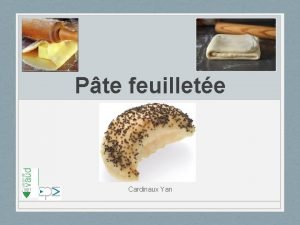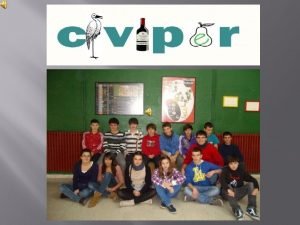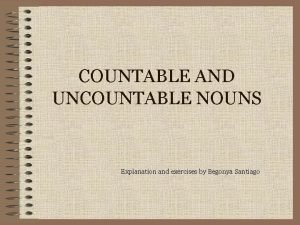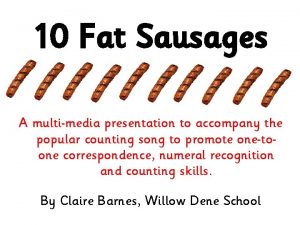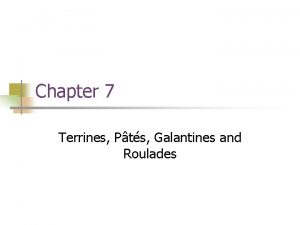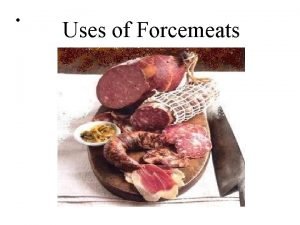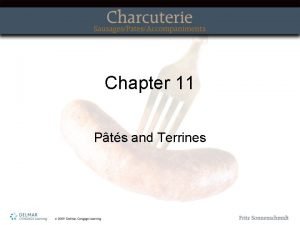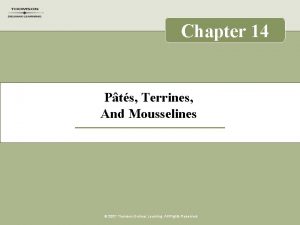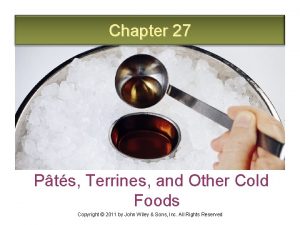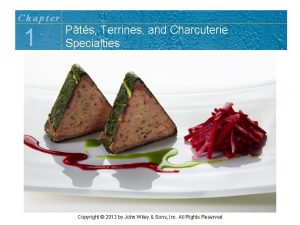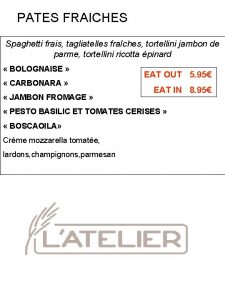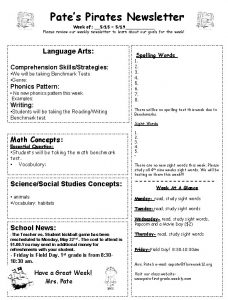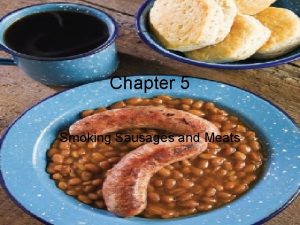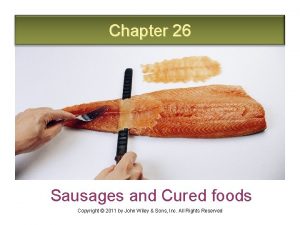Forcemeats For Sausages Terrines Pates Roulades Galantines and



















- Slides: 19

Forcemeats For Sausages, Terrines, Pates, Roulades, Galantines, and Other Charcuterie Items

What is a forcemeat? n A preparation made from uncooked ground meats, poultry, or fish, seasoned, then emulsified with fat

Forcemeats n This is the basic component of many charcuterie items. n A lean meat & fat emulsion that is achieved by grinding, sieving, or pureeing these items together in a controlled environment n Result must be an emulsion, not just a mixture, so that it will hold together properly when sliced. n Should have a rich & pleasant taste & mouthfeel.

Forcemeat Styles n Each style has its own particular texture Straight Forcemeats n Country-Style Forcemeats n In Gratin Forcemeats n Mousseline (Very Light) Forcemeat n

Straight Forcemeat n Combination of Pork & Pork Fat with a dominant meat in equal parts through a process of progressive grinding & emulsification. n Meats & fat cut into cubes, seasoned, cured, rested, ground, then processed. n Egg or cream may be added for a better bind

Country-Style Forcemeat n Coarse in Texture n Traditionally made from pork & pork fat with the addition of liver & other garnishes. n Heartier in flavor than other forcemeats

Gratin Forcemeat n Some portion of the dominant meat is sauteed (just enough to enhance color & flavor) & cooled before grinding n Thus, “gratin” (browned) n Steps: Sear the meat (Very Hot Pan, short cooking time) n Cool down very quickly (small batches in pan, transfer immediately to freezer or cooler) n Reduction may be made & chilled before use n Same procedure as a straight forcemeat n

Mousseline Forcemeat n Based on tender, lean, white meats, shellfish, or fish. n The addition of cream or eggs give the characteristic of light texture & consistency n Starting Formula: 1 # Meat or Fish n 1 tsp. Salt n 1 ea. Egg or Egg White n 1 cup Cream n

Ingredients of Forcemeats n Main Ingredient n Salt & Seasonings n Secondary Binders n Garnish Ingredients

Main Ingredient n Classic Choices for Forcemeats: n Pork n Fish n n Seafood n n Pike, Trout, Salmon Shrimp, Scallops Game Meats n Venison, Boar, Rabbit Poultry & Game Birds n Livers n n Poultry, Game, Veal, Pork

Main Ingredient – cont. n For Main Ingredient Meats, choose well-exercised cuts – richer flavor n More tender cuts should be used as garnish meats n Recipes with seafood mousselines will often call for pike to ensure a good primary bond n An adequate amount of fat is also important n n Fatback for meats – neutral flavor Heavy Cream for white meat, fish, & shellfish (Mouselines) n Meats & Fatback should be trimmed of silverskin, gristle, sinew & skin

Salt & Seasonings n Salt very important to draw out proteins in meat (primary bind) and adds flavor n Classic recipes often call for ground spices such as quatre epices (pepper, nutmeg, allspice, & cinnamon) n Seasoning or marinating meats prior to grinding also add flavor n Addition of aromatics (herbs, veg, wines, cognacs, spirits, vinegars, reductions) n Most important – follow basic formulas & taste!!

Secondary Binders n Primary or Basic Binder – Proteins found in meats being used. (Provide structure, texture & basic ability to bind) n In some special cases, a Secondary Binder is necessary. (Country-Style & Gratin Forcemeats) n Three Basic Secondary Binders: Eggs (or whites only) n Nonfat Dry Milk Powder n Panadas n

A Pana – what? n Panada – something other than fat to enchance smoothness and to aid emulsification n Crustless white bread (usually soaked in milk/cream) Heavy bechamel Rice

Garnish Ingredients n Add Color, Flavor, & Texture to a basic formula n Traditional Garnishes: n Poultry breast n Pork, beef, veal, or lamb t-loin portions n Nuts (esp. pine nuts & pistachios) n Mushrooms n Truffles n Diced foie gras n The amount added varies from very little to predominantly garnish

Garnish Ingredients – cont. n Garnishes are added in two ways: n Folded into forcemeat; integral or random n Placing it into the forcemeat as you fill a mold or laying it out for a roulade or galantine; inlays or centered For garnish or competition purposes, dusting with powdered gelatin or albumen or a combination of the two will glue your layers into place

Making Forcemeats n Chill Ingredients & Chill Equipment n Forcemeats must be kept below 30°F n If kept cold, require less fat & still have good texture n Progressive Grind n Mix & Process n To blend any seasonings, panadas or other ingredients

Cooking a Forcemeats are cooked in the following manners: n Poached directly in a liquid (galantines, roulades, or quenelles) n In a waterbath (terrines) n Baked in a Crust (pate en croute) A test of your forcemeat is very important to ensure a quality end product

Testing a Forcemeat n Wrap 1 oz. Portion in Plastic Wrap & Poach to Proper Internal Temp n Cool to correct service temp before tasting n Check for flavor, seasoning, & consistency n The taste will not be the same as the finished product since forcemeat products should sit for at least 2 day n If Rubbery – add more fat or cream n If Loose – add egg whites or panada
 Classification des pates
Classification des pates Pates
Pates Pates creek elementary school
Pates creek elementary school Pates el robledillo
Pates el robledillo King prawn curry or fat greasy sausages
King prawn curry or fat greasy sausages Sausages countable or uncountable
Sausages countable or uncountable 10 fat sausages
10 fat sausages Fspos
Fspos Typiska drag för en novell
Typiska drag för en novell Tack för att ni lyssnade bild
Tack för att ni lyssnade bild Vad står k.r.å.k.a.n för
Vad står k.r.å.k.a.n för Shingelfrisyren
Shingelfrisyren En lathund för arbete med kontinuitetshantering
En lathund för arbete med kontinuitetshantering Underlag för särskild löneskatt på pensionskostnader
Underlag för särskild löneskatt på pensionskostnader Personlig tidbok för yrkesförare
Personlig tidbok för yrkesförare A gastrica
A gastrica Densitet vatten
Densitet vatten Datorkunskap för nybörjare
Datorkunskap för nybörjare Stig kerman
Stig kerman Debatt artikel mall
Debatt artikel mall
